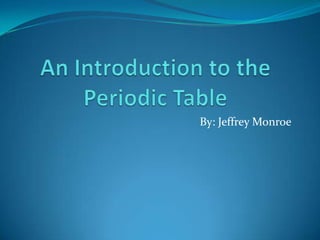
An introduction to the periodic table
- 1. An Introduction to the Periodic Table By: Jeffrey Monroe
- 2. The Modern Periodic Table
- 3. The Beginning The Modern Periodic Table began developing in 1896 by Dmitri Ivanovich Mendeleev based on what he discovered and called the periodic law The Periodic Law States: that the physical and chemical properties of the elements tend to recur in a systematic manner with increasing atomic number
- 4. Properties of the Table The Table of Elements Consists of the Following: Groups Periods Metals Nonmetals Metalloids Halogens Noble Gases Lanthanides Actinides
- 5. Groups and Periods Groups: There are 18 groups that are arranged from left to right horizontally across the periodic table. An observer can see the roman numerals IA – VIIIA at the top of each column Groups 1-2 and 13-18 are called the representative elements because they are the most commonly used and studied elements Groups 3-12 are called the transition metals because of there unusual reactive characteristics Periods: There are 7 periods arranged from top to bottom vertically down the periodic table An observer can see the numbers 1-7 of the left side of the table that represent energy levels that are most closely studied during electron configuration
- 6. Metals, Nonmetals, & Semimetals Metals can be seen, with the exception of hydrogen, in groups 1 and 2 of the periodic table and on our table in slide 2 are represented by the royal blue shading. Metals are defined as chemical elements that are good conductors of both electricity and heat More specifically group 1 metals are known as the alkali metals and group 2 are known as the alkaline earth metals Nonmetals are represented by the greenish shading in groups 14-18 Nonmetals are defined as chemical elements lacking typical metallic properties Semimetals or Metalloids are represented by the orange shading in groups 13-16 Semimetals are defined as chemical elements with properties intermediate between those of typical metals and nonmetals
- 7. Halogens & Noble Gases Halogens: this group of chemical elements are observed to be in group 17 and most known because of the highly reactive characteristics Noble Gases: this group of chemical elements are observed to be in group 18 and known for being highly unreactive The difference between these groups of elements reactivity has to do with the number of valence electrons each element posesses. Valence Electrons are defined as are the electrons in the last shell or energy level of an atom and thus responsible for chemical bonding
- 8. Reactivity Notice the figure 1 of the left. It possesses eight valence electrons on its outer most shell. This shows a full valence shell according to the octet rule and explains why noble gases like neon are not reactive. Because it has a full valence shell neon does not require any other electrons thus it does not need to reactive with another chemical to get any other electrons. The Octet Rule States: that atoms tend to gain, lose or share electrons so as to have eight electrons in their outer electron shell Therefore any chemical element that does satisfy the octet rule will react in any way chemically possible to get its full valence shell Figure 1
- 9. Periodic Trends Periodic Trends are the tendencies of certain elemental characteristics to increase or decrease as one progresses along a row or column of the periodic table of elements. Atomic Radius:atomic radius tends to decrease as one progresses across a period from left to right and bottom to top Electron Afffinity:As one progresses from left to right across a period, the electron affinity will increase Electronegativity:as one moves from left to right across a period the electronegativity increases
- 10. The End or is it? As we continue to study chemistry and more advancements are made in the field we never know who will be next to improve on this monument of chemical history. Maybe it will be one of you students!
- 11. References www.astro.virginia.edu Reich-chemistry.wikispaces.com Dingrando, Laurel. “Chemistry: Matter and Change”. Glencoe/Mcgraw-Hill 30 Jan. 2008